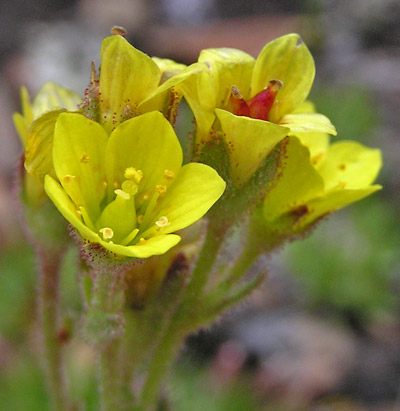Saxifraga
|
Family: Saxifragaceae |
Herbs perennial (biennial in S. adscendens, annual in S. tridactylites), sometimes rhizomatous, sometimes stoloniferous; caudex not fleshy, scaly, sometimes with bulbils; herbage hairy or stipitate-glandular, sometimes glabrous. Flowering stems ± erect, leafy, 1-40[-100] cm. Leaves in basal rosette and cauline, alternate (opposite in S. nathorstii, S. oppositifolia), cauline reduced; stipules absent; petiole absent or present; blade obovate, oblong, oblong-obovate, elliptic, linear, spatulate, or oblanceolate to ovate, reniform, or round, lobed or unlobed, base cuneate to cordate, ultimate margins entire, crenate, serrate, or dentate, (with lime-secreting hydathodes in S. aizoides, S. nathorstii, S. oppositifolia, S. paniculata), apex acute to obtuse or rounded; venation pinnate or palmate. Inflorescences thyrses or, sometimes, cymes, sometimes solitary flowers, terminal from terminal bud in rosette, 2-200[-1000]-flowered, (some or all flowers replaced by bulbils in S. cernua, S. mertensiana), usually bracteate (ebracteate in S. nathorstii, S. oppositifolia); (bracts leaflike). Flowers [bilaterally symmetric], bisexual (unisexual and plants sometimes gynodioecious, or plants dioecious in S. eschscholtzii); hypanthium free from or 1/4-3/4 adnate to ovary, free from ovary to 0.5 mm, green or pink to purple, (0.1-4 mm); sepals 5, green, sometimes reddish at tips, sometimes ± purple; petals absent or (1-)5, white, cream, yellow, orange, red, pink, or purple, often yellow-, orange-, or red-spotted; nectary disc present or not; stamens 10, (distinct); filaments linear and ± flattened (club-shaped in S. mertensiana); ovary superior to ± inferior, sometimes appearing more superior in fruit, 2-locular, carpels usually (1/4-)1/2 connate proximally or ± distinct; placentation axile (when connate 1/2+ their length) or appearing marginal; styles 2; stigmas 2. Capsules 2(-3)-beaked (± folliclelike in S. oppositifolia). Seeds brown, oblong, ellipsoid, or ovoid, smooth, tuberculate, or papillate. x = 6, 8, 11, 13, 14. Saxifraga has had differing treatments (e.g., J. K. Small and P. A. Rydberg 1905b; H. G. A. Engler and E. Irmscher 1916; P. E. Elvander 1984; D. A. Webb and R. J. Gornall 1989). Most have been based on morphology and cytology. Relationships among species are difficult to assess. The broad Linnaean concept of the genus had been accepted by most recent authors. Molecular phylogenetic data (summarized by D. E. Soltis et al. 2001) show that Saxifraga as traditionally understood is polyphyletic and should be divided into two main groups, Saxifraga in the narrow sense and Micranthes Haworth, the treatment followed here. Other taxa, notably the North American Cascadia, must also be recognized. Cascadia differs from both Saxifraga and Micranthes in its lax, trailing stems and only cauline leaves, its carpels connate only proximally and each independently adnate to the hypanthium, and its spiny seeds; its ovules are bitegmic as in Saxifraga; ovules are unitegmic (except for sect. Merkianae) in Micranthes. In addition, Saxifraga and Micranthes differ by the following traits: leaves basal and cauline (these sometimes reduced and bractlike) in the former versus basal only (or proximally crowded) in the latter (the flowering stems being leafless); carpels usually connate more than one-half versus less than one-half, although there is variation in both genera for this trait; seeds smooth, tuberculate, or papillate versus longitudinally ribbed; and pollen striate or granular versus reticulate (L. Brouillet and R. J. Gornall 2007). Saxifraga in the narrow sense, as adopted here, includes most sections of the traditional genus as well as a majority of the species. In North America fewer species belong to Saxifraga than to Micranthes. Eight species of Saxifraga are endemic to North America. A single introduced species has established itself in the flora area; other garden species have usually not escaped or were ephemeral. The following species are excluded from this treatment: S. cymbalaria Linnaeus (misidentification of S. sibthorpii Boissier, a garden plant, not established), S. ×geum Linnaeus and S. umbrosa Linnaeus (both misidentifications of S. hirsuta specimens), and S. hirsuta Linnaeus (not established). The report of S. stolonifera Meerburgh (syn. S. sarmentosa Linnaeus f.) from California is old; there has been no recent collection, and that species also is excluded here.
CAUDEX: or rhizome usually with scales, sometimes with bulblets. LEAVES: basal, sometimes also cauline; blade ovate to circular in ours, the base attenuate to cordate, the margin entire to lobed, dentate, or serrate. INFLORESCENCE: generally cymes or panicles covered with cream-yellow to pink or purple glandular hairs. FLOWERS: actinomorphic in ours, sometimes only 1 or 2; hypanthium more or less fused to ovary in ours; sepals usually green, erect to spreading or reflexed; petals white, rarely yellow or spotted, entire; stamens 10, anthers usually pale-yellow to orange; ovary superior to more or less inferior, sometimes more superior in fruit; nectaries disk-like, ribbon-like or obscure; locules, placentae, styles 2(-3), the placentae axile. FRUITS: 2(-3) valved. SEEDS: smooth to ridged. NOTES: Ca. 300 spp., chiefly n temperate, arctic, alpine regions. (Latin: saxum = stone + frangere = to break, referring to bulblets which were thought to dissolve urinary concretions). Elvander, P. 1984. Syst. Bot. Monogr. 3:1-44. REFERENCES: Elvander, Patrick. 1992. Saxifragaceae. Ariz.-Nev. Acad. Sci. 26(1)2. Fls perfect, regular or slightly irregular, 5-merous; hypanthium usually adnate to the base of the carpels, sometimes essentially free; pet mostly narrow; stamens 10; carpels mostly 2, connate at least at the base, with axile placentas, ripening into a bilobed capsule or nearly distinct follicles; perennial herbs with the principal lvs usually in basal rosettes or crowded on basal shoots, the flowering stem commonly with few or no lvs, the fls mostly in branched, cymose or cymose-paniculate infls, rarely solitary and terminal. (Antiphylla, Chondrosea, Hydatica, Leptasea, Micranthes) 350, Arctic, N. Temp., Andes. Gleason, Henry A. & Cronquist, Arthur J. 1991. Manual of vascular plants of northeastern United States and adjacent Canada. lxxv + 910 pp. ©The New York Botanical Garden. All rights reserved. Used by permission. |

